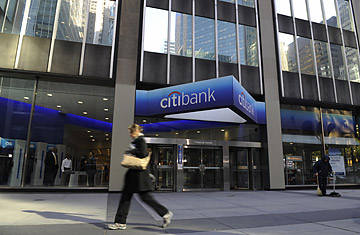
Citibank branch at the US bank Citigroup world headquarters on Park Avenue, in New York.
(2 of 3)
2. File for Bankruptcy
For months, Citigroup has been dogged by concerns about the quality of the loans on its books. Citi was, after all, one of the nation's largest sub-prime lenders, not just to homebuyers but through its credit card division as well. This week, the fears have centered on the quality of its corporate loans, and to a lesser extent its credit card business.
"If they had to mark all of their loans down to what they would be worth, there would be no equity left in the company," says Ellman.
Here's the math: Citigroup has, as Mayo said, about a $100 billion equity cushion, which could be wiped out if loans go bad. At the end of the third quarter, Citigroup had $17 billion in commercial mortgage bonds. According to Barclays Capital, the average CMB price has fallen 34% since the beginning of October. So erase $5.8 billion in equity right there. Citigroup was also a player in advising private equity companies on leveraged buyouts. As part of that business it lent money to the companies in such transactions. Now many of those deals look over-leveraged and ready to default. Those bonds are off 19% since the end of September. Citigroup holds $23 billion in leverage loans. So mark down that stake by $4.4 billion.
In addition, Citigroup holds $172 billion in loans to corporations. In general, corporate bonds have not fallen a lot because there have not been many defaults. The aggregate Barclays corporate bond index is down 3%. Still, because of the size of Citigroup's loan book, wave goodbye to another $5 billion.
You may have read about Citigroup's Special Investment Vehicles. Through SIVs and other structures Citigroup has kept some of its loan liabilities off its balance sheet. On Wednesday, Citigroup said it would repurchase the last of those SIV assets for $17 billion. But Citigroup still has a remarkable $130 billion in unfunded off-balance-sheet liabilities. Not all of that will go bad. But conditions don't look good for the $2.5 billion in obligations to off-balance-sheet collateralized debt obligations, or to a lesser extent the $63 billion it has in asset-backed debt.
All of these potential losses are based on the value that Citi is putting on its loans. And Citi has no obligation to write down all of the loans on its books. In fact, it recently said that it was going to stop taking so-called mark-to-market losses on an additional $80 billion in assets of its loan portfolio. So even if the value of its loans continues to fall, it may not have to take a hit to its equity. And as long as most of Citi's borrowers keep paying, as most are, Citi will be just fine. That's why most analysts see the possibility of the bank going bankrupt as out of the question.
But if Citi has not been marking its loans down to market value aggressively enough, the losses on its balance sheet could be even greater, which could be the case. "Though difficult to draw hard conclusions from comparisons between banks, Citi's marks appear less aggressive than J.P. Morgan's," wrote analyst John McDonald of Sanford C. Bernstein in a research report last week.
All told, McDonald thinks that Citigroup has $88 billion in risky assets. That's not quite $100 billio,n but it is close. And that's what has the Citi-doomsday-folk yapping.
